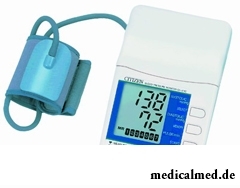





Measurement of pressure
 Measurement of arterial pressure - an important diagnostic method of inspection. Measurement of arterial pressure is considered by physicians as the main pre-medical procedure which to carry out, as required, important to be able independently at home.
Measurement of arterial pressure - an important diagnostic method of inspection. Measurement of arterial pressure is considered by physicians as the main pre-medical procedure which to carry out, as required, important to be able independently at home.
The device for measurement of pressure
For these purposes the special device for measurement of pressure, the called tonometer is used. It consists of such elements:
- Sphygmomanometer;
- Manometer.
The main parts of the sphygmomanometer are a rubber cuff for crossclamping of an artery and a cylinder (pump) for air forcing. Manometers happen spring and mercury.
Usually, tonometers with use of a stetofonendoskop (a stethoscope, a phonendoscope) are applied to measurement of arterial pressure. Measurement is performed by an acoustical method of Korotkov.
Basic rules of measurement of arterial pressure
Arterial pressure needs to be measured, following the following rules:
1. It has to be indoors warm;
2. The patient has to sit or lie conveniently on spin. Before measurement of pressure of people has to have a rest within 10 – 15 minutes. It should be noted that in lying situation pressure, usually, is put 5 - 10 mm lower, than at its measurement in a sitting position;
3. Directly during measurement of arterial pressure the patient has to observe tranquility: not to talk and not to look at the device for measurement of pressure;
4. The hand of the patient has to be absolutely naked, the palm has to look up and conveniently be located at the level of heart. The raised sleeve of clothes should not press on veins. Muscles of the patient have to be absolutely relaxed;
5. From a device cuff for measurement of pressure carefully expel the air rest;
6. Densely impose a cuff on a hand, at the same time, without pulling together it strongly. The bottom edge of a cuff has to be located 2 - 3 cm above a bend in an elbow. Then the cuff is tightened or connected a flypaper;
7. The stethoscope, densely, but without pressure is put to an internal dimple on an elbow. It is the best of all if it is with 2 ears and rubber (polyvinyl chloride) tubes;
8. In complete silence, by means of a device cylinder for measurement of pressure, gradually force air in a cuff, at the same time, pressure in it is registered the manometer;
9. Air is forced until tones or noise in an elbow artery tones then raise pressure in a cuff approximately by 30 mm a little stop;
10. Now forcing of air is stopped. Slowly the small crane at a cylinder opens. Air begins to come out gradually;
11. Height of a mercury column (value of upper pressure) with which clear noise is for the first time heard is fixed. At this moment air pressure in the device for measurement of pressure decreases in comparison with pressure level in an artery in this connection the wave of blood can get into a vessel. Thanks to it tone (on a sound she reminds a loud pulsation, heart beat) is also caused. This size of upper pressure, the first indicator, is an indicator of the maximal (systolic) pressure;
12. In process of further pressure decrease of air in a cuff, there are not clear noise, and then tones are again listened. These tones gradually amplify, then become clearer and sonorous, but then suddenly weaken and completely stop. Disappearance of tones (heart beat sounds) testifies to an indicator of the minimal (diastolic) pressure;
13. The additional indicator revealed when using methods of measurement of pressure - the size of pulse amplitude of pressure or pulse pressure. This indicator is estimated by subtraction from the maximum size (systolic pressure) minimum (diastolic pressure). Pulse pressure – important criterion for assessment of a condition of cardiovascular system of the person;
14. The indicators received using methods of measurement of pressure register in the form of the fraction divided by inclined line. The upper figure means the size of systolic pressure, lower – diastolic.
Features of measurement of pressure
 At measurement of arterial pressure several times in a row, it is necessary to pay attention to some features of an organism. So, values of indicators at the subsequent measurement are, as a rule, slightly lower, than at the first measurement. Exceeding of indicators at the first measurement can be caused by the following reasons:
At measurement of arterial pressure several times in a row, it is necessary to pay attention to some features of an organism. So, values of indicators at the subsequent measurement are, as a rule, slightly lower, than at the first measurement. Exceeding of indicators at the first measurement can be caused by the following reasons:
- Some hyperphrenia;
- Mechanical irritation of nervous network of vessels of blood.
In this regard, measurement of arterial pressure is recommended to repeat, without removing at the same time a cuff from a hand after the first measurement. Thus, having applied methods of measurement of pressure several times as the result is fixed by average values.
Pressure in the right and left hand often are various. Its size can differ on 10 – 20 mm. Therefore, physicians recommend to apply methods of measurement of pressure on both hands, and to fix average sizes. Measurement of arterial pressure is performed consistently on the right and left hands, several times, and the received sizes then use for calculation of an arithmetic average of an indicator. For this purpose, sizes of each indicator (separately upper pressure and separately lower) are put and divided into that number of times how many measurement was performed.
If at the person unstable arterial pressure is observed, measurement needs to be performed regularly. Thus, it is possible to catch communication of changes in its level in connection with influence of various factors (a dream, overfatigue, food, work, rest). All this needs to be considered at use of methods of measurement of pressure.
Normal amounts, when using any method of measurement of pressure, are pressure indicators at the level of 100/60 - 140/90 mm of mercury.
Possible mistakes
It must be kept in mind that sometimes between upper and lower pressure intensity of tones can weaken, times considerably. And then this moment can be taken for too high pressure by mistake. If to continue to let out the air from the device for measurement of pressure, the loudness of tones increases, and they will stop at the level of the real lower (diastolic) pressure. If pressure in a cuff is insufficiently lifted, it is possible to be mistaken in value of systolic pressure easily. So, not to make a mistake, it is necessary to use methods of measurement of pressure correctly: to raise pressure level in a cuff rather highly that "pressed", and here letting out the air, it is necessary to continue to listen to tones before full pressure drop to zero.
Also one more mistake is possible. If strongly to press a phonendoscope a humeral artery, at some people tones are listened to zero. Therefore, it is not necessary to press a phonendoscope head directly on an artery, and value of the lower, diastolic pressure, it is necessary to record on sharp decrease in intensity of tones.
Stomatologists appeared relatively recently. In the 19th century to pull out painful teeth belonged to duties of the ordinary hairdresser.

All diseases from nerves – in this joke a big element of truth, are said by doctors. Constant stresses lead body to decrease in protective forces...
Section: Articles about health
On the head of the person about one million hair follicles, or as they are called still, hair bulbs are located. At the time of the birth most of them is in the "sleeping" state, but within several weeks follicles become more active, and from them begin р...
Section: Articles about health
Obesity is called a disease of 21 centuries, for the last 100 years the number of the people suffering from excess body weight considerably increased. Statistically, on Earth already about 1,5 billion corpulent people, and 500 million from them have the extreme degree of completeness negatively affecting quality and duration of their life. What served as the reason of growth of stout persons on the planet? How not to get to their ranks? Let's consider five main premises for increase in body weight in conditions современнос...
Section: Articles about health
For the time being the perspective of heart diseases seems to most of people remote and foggy. But sooner or later практичес...
Section: Articles about health
About 10-15 years ago existence of the computer in the apartment of the Russian was considered as a rarity and office rooms were only at the first stage of equipment by these useful devices. Today practically in each house there is a computer (and often not one), and to constants...
Section: Articles about health
Bathing in broths of medical flowers and plants (phytobathtub) was eurysynusic since Cleopatra who is a good judge in all that concerns beauty and health. And today phytobathtubs is the simple and available means allowing not only to remove nervous tension, but also to recover from many diseases. Grass bathtubs at treatment of cold, osteochondrosis, radiculitis, skin diseases, and also diseases of urinary tract and vessels are especially effective....
Section: Articles about health
Partial and the more so full loss of hearing significantly reduces quality of life. Difficulties with communication lead to loneliness and замкн...
Section: Articles about health
Practice of hypnotic impact on consciousness of the person contains about two millennia. During this time scientists managed to learn a lot of things about a phenomenon of hypnosis and learned to facilitate a condition of the patients having heavy illnesses with its help....
Section: Articles about health
For the last decades the diabetes mellitus of the second type became really world problem. The number of cases annually increases, and average age of patients for whom the illness is diagnosed, steadily decreases. Specialists consider that one of the main reasons for this trouble is disturbance of a diet. In other words, the huge number of people regularly overeats or excessively is fond of the products causing glucose exchange process failures....
Section: Articles about health
Bulimia and anorexia, are heavy deviations of a feeding behavior, become a cause of death of patients much more often than all others...
Section: Articles about health
The mankind knows that some toxins at intake in the minimum quantities have therapeutic effect from an extreme antiquity. Many substances recognized poisonous are applied in the medical purposes also today, being the main deystvuyushch...
Section: Articles about health
Within several decades of our compatriots convinced that the use of butter nasty affects a condition of coronary vessels. As a result the reputation of a product was impaired thoroughly a little, and many almost ceased to include it in the diet, having given preference "to safer" to vegetable fats. Meanwhile, the last researches showed that harm of butter for health is strongly exaggerated. But the product has a number of unique properties, to...
Section: Articles about health
Climax - process of fading of reproductive function of an organism in process of its aging. At women the main sign of its approach showing...
Section: Articles about health
Memory is an ability of the central nervous system to fix, keep and as necessary to reproduce information on knowledge or skills received by the person or an animal during life. The mechanism of this process is up to the end not studied....
Section: Articles about health
Statistically cystitis 25-30% of women up to 40 years have. With age this indicator raises, besides many do not get to statistics because do not see a doctor. The most sad that after the regular visits to doctors, long reception of antibiotics and life in the mode "it is necessary to take care" cystitis all the same is returned to a half of women. Symptoms of cystitis are unambiguous and it is impossible to confuse them with anything: bladder pain, burning at an urination, frequent desires to go to a toilet, a vynuzhd...
Section: Articles about health
Tuberculosis – a serious infectious disease which development is caused by mycobacteria (Koch's bacilli). The illness is known from a deep d...
Section: Articles about health
Scientists always aimed to offer fundamental explanations for medical problems. Their theories formed the basis of modern methods of treatment of the hardest pathologies and helped to save a set of lives. However stories are known also such theoretical constructions, following to...
Section: Articles about health
History of use of an anesthesia during operations contains more than 160 years. Annually in the world hundreds of thousands of surgical interventions during which to patients the substances immersing them in a dream and saving from pain are entered are carried out. Using an anesthesia many myths and delusions are still connected. It is worth getting acquainted with the most widespread of them....
Section: Articles about health
For residents of the countries of Southeast Asia various algas are an obligatory component of a daily diet. Their priest...
Section: Articles about health
Many parents of children at the age of 2-4 years face excessively whimsical behavior of the child. The kid exhausts constant crying and whims not only the parents, but also himself. In what the reasons of children's whims. And how to fight with them?...
Section: Slideshow
Practice of use of table salt in the therapeutic purposes contains not one century. Applications which do by means of the fabric impregnated with saline solution are considered especially effective. They have antibacterial and antiinflammatory effect, help to heal wounds, exempt fabrics from excess liquid. Hypertonic salt solution of potassium chloride is applied outwardly at many morbid conditions. Let's tell about the most known of them....
Section: Articles about health
No, probably, the person who would not have cold. Cold, cough, a headache – these symptoms are known to everyone. Peak to Prost...
Section: Articles about health
It is known that the person for 80% consists of water which participates in all processes of an organism. The person loses liquid daily – as a result of sweating, breath, an urination, and its insufficient completion due to various reasons can bring to обезвожив...
Section: Articles about health
The immunity role in growth of the child is invaluable. The proteins-immunoglobulins produced by immune system preserve the child against the diseases capable − owing to an organism weak still − to serve as a stressful factor, to become the reason of many complications and delays in development of the kid. If the immune system weakened, health of the child is under direct threat and needs active actions for strengthening of protective forces of an organism − preferably non-drug....
Section: Articles about health
Season of activity of viral infections in the heat. Everyone can get sick, but probability of this unpleasant event it is possible and it is necessary miny...
Section: Articles about health
The medicine promptly develops, and the fact that else quite recently it seemed by miracle can now. We are not surprised any more to the fact that people with artificial joints and extremities can play sports, organ transplantation became a routine, and the latest cancer medicine п...
Section: Articles about health
For the help to doctors in the choice of optimal solutions for treatment of various diseases the Cochrane scientific organization (Cochrane) conducts joint researches with representatives of scientific community around the world. The analysis of a series of the conducted researches of the drug Oscillococcinum® relating to group of cold remedies became one of the last methanolyses....
Section: Articles about health
